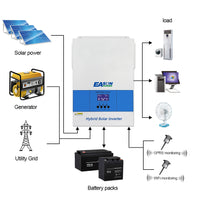Unlock the Power of the Sun: Discover the Perfect Solar Charge Controller for Your Energy Needs!
As the world becomes increasingly aware of the need for sustainable energy sources, solar energy has emerged as a leading solution. It harnesses the power of the sun to provide clean, renewable energy for homes, businesses, and beyond. At the heart of any solar energy system is the solar charge controller, a critical component that ensures the efficient charging of batteries from solar panels. This article aims to guide you through the essentials of solar charge controllers, helping you choose the right one tailored to your energy needs. Whether you're a seasoned solar enthusiast or just starting, understanding these devices will empower you to maximize your solar energy systems.

Understanding Solar Charge Controllers
A solar charge controller is an essential device that regulates the voltage and current coming from your solar panels to your batteries. Its primary function is to ensure that batteries are charged efficiently and safely, preventing overcharging and enhancing battery life. There are two main types of solar charge controllers: Pulse Width Modulation (PWM) and Maximum Power Point Tracking (MPPT). PWM controllers are simpler and more cost-effective, making them suitable for smaller systems. They work by reducing the voltage from the solar panel to match the battery's voltage, which can lead to some energy loss. On the other hand, MPPT controllers are more advanced and can optimize the power output by adjusting their input to draw the maximum available power from the solar panels. Although they are typically more expensive, MPPT controllers are highly efficient and ideal for larger solar setups or systems that demand more power. Understanding these differences is crucial when selecting a solar charge controller that will best serve your energy needs.
Key Factors to Consider When Choosing a Solar Charge Controller
Choosing the right solar charge controller involves considering several key factors. First and foremost, ensure that the controller is compatible with your system's voltage—commonly 12V, 24V, or 48V. This compatibility is vital for the proper functioning of your solar energy system. Next, assess the current rating of the controller, which should match or exceed the maximum current output of your solar panels. Efficiency is another critical consideration; look for controllers with high conversion rates to minimize energy loss. Features can also enhance your experience: controllers with LCD displays provide real-time data on system performance, while built-in protections against overcharging and short circuits add an extra layer of safety. These factors collectively will help you find a solar charge controller that not only meets your technical requirements but also offers reliability and ease of use.
Assessing Your Energy Needs
Before purchasing a solar charge controller, it's crucial to evaluate your energy needs based on your existing solar panel setup, battery capacity, and usage requirements. Start by calculating the total wattage of your solar panels and how much energy you expect to use daily. For instance, if you have a solar panel system rated at 300 watts and plan to run devices that consume 150 watts per hour, you'll need a charge controller that can handle the energy inflow and outflow effectively. Additionally, consider the capacity of your batteries, as this will dictate how much energy can be stored and used. A good rule of thumb is to select a charge controller that can handle at least 25% more current than your system's maximum output to ensure optimal performance. By assessing these elements, you can determine the appropriate size and type of solar charge controller that will suit your specific energy demands.
Where to Purchase a Solar Charge Controller
When it comes to purchasing a solar charge controller, you have several options at your disposal. Online retailers offer a vast selection and often provide user reviews which can help inform your decision. Local shops can also be a great choice, especially if you prefer to consult with knowledgeable staff who can answer your questions in person. Specialized solar energy suppliers are another excellent option, as they typically carry a range of high-quality products and provide valuable support and guidance. Regardless of where you choose to buy, prioritize reliability and customer service, as these factors can significantly enhance your purchasing experience and ensure that you receive the support you need for your solar energy journey.
Final Thoughts on Choosing a Solar Charge Controller
In conclusion, selecting the right solar charge controller is a vital step in optimizing your solar energy system. By understanding the various types of controllers available, the key factors to consider, and assessing your unique energy needs, you can make an informed decision that enhances the efficiency of your solar setup. Remember, the right charge controller not only protects your batteries but also maximizes your investment in solar energy. We encourage you to explore your options, take into account the insights shared in this article, and embark on your solar energy journey with confidence.








